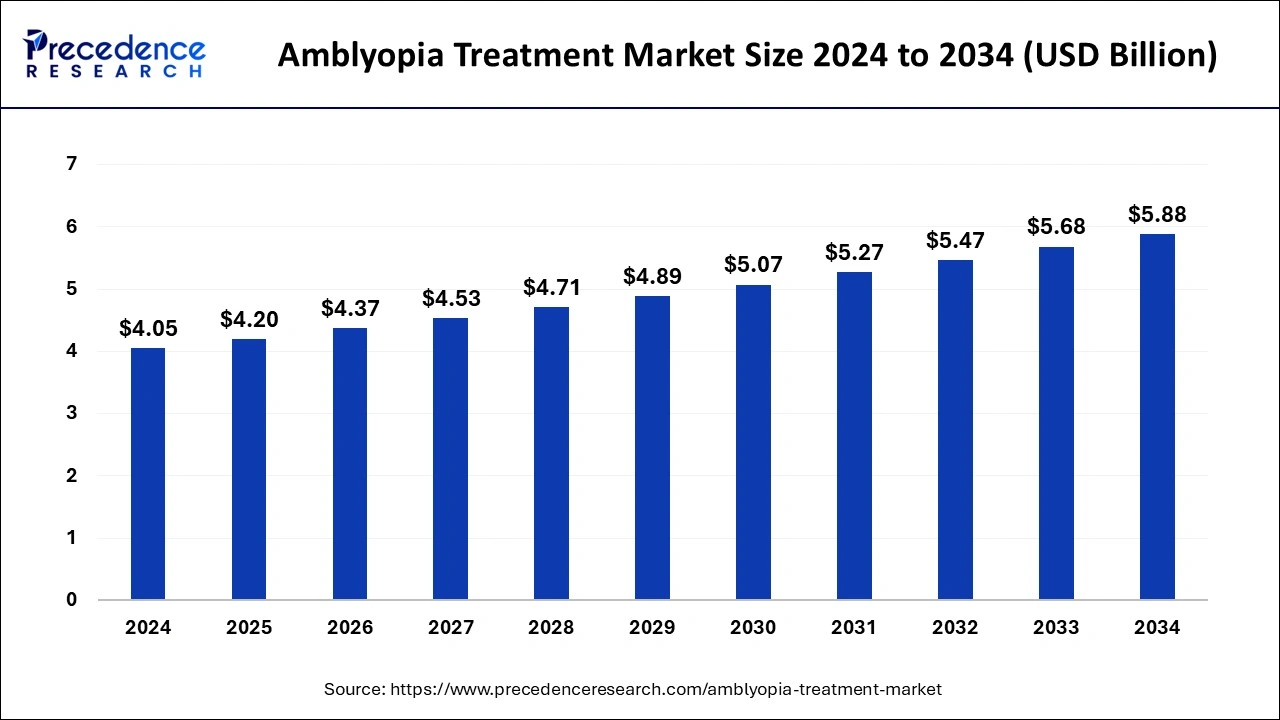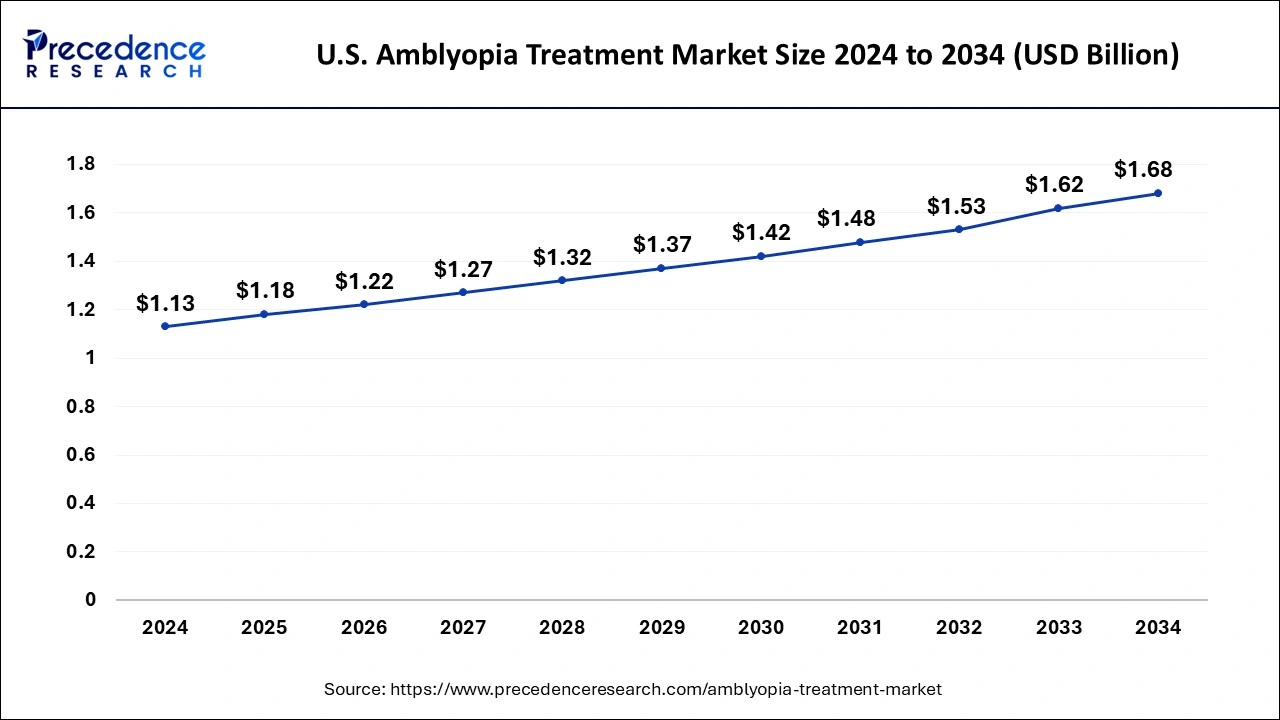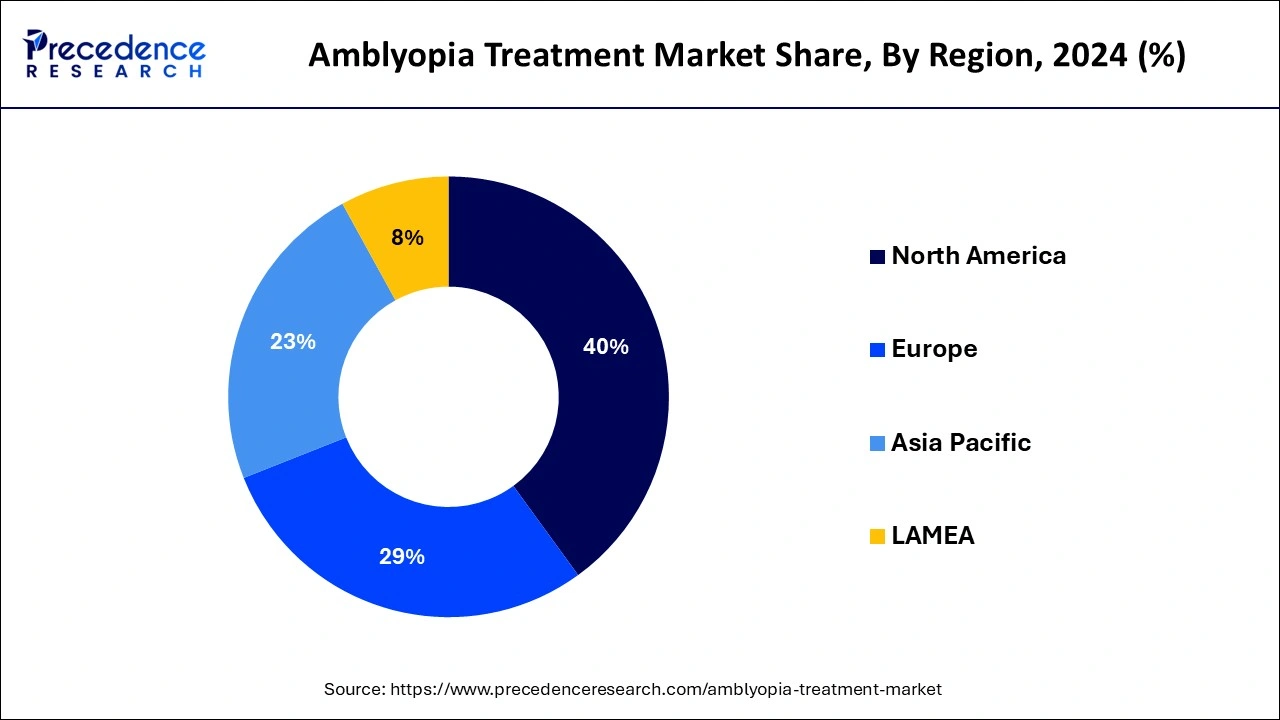January 2025
The global amblyopia treatment market size is calculated at USD 4.20 billion in 2025 and is forecasted to reach around USD 5.88 billion by 2034, accelerating at a CAGR of 3.80% from 2025 to 2034. The North America amblyopia treatment market size surpassed USD 1.62 billion in 2024 and is expanding at a CAGR of 3.82% during the forecast period. The market sizing and forecasts are revenue-based (USD Million/Billion), with 2024 as the base year.
The global amblyopia treatment market size was calculated at USD 4.05 billion in 2024 and is expected to reach around USD 5.88 billion by 2034, expanding at a CAGR of 3.80% from 2025 to 2034. The amblyopia treatment market is driven by an increase in amblyopia's prevalence.

AI technologies help physicians tailor amblyopia treatment to each patient's needs. AI has the ability to enhance the efficacy of the treatment. By analyzing patient's conditions, AI technology discovers ideal medical treatments for individual patients. Moreover, AI technologies help in the early detection of eye disorders, allowing physicians to make timely decisions. AI-enabled treatments offer better results for amblyopia patients, thereby enhancing outcomes.
The U.S. amblyopia treatment market size was exhibited at USD 1.13 billion in 2024 and is projected to be worth around USD 1.68 billion by 2034, poised to grow at a CAGR of 4.05% from 2025 to 2034.

North America had dominated in the amblyopia treatment market in 2024. North America has some of the world's most sophisticated healthcare infrastructures, especially in the United States and Canada. This includes cutting-edge medical facilities with the newest equipment and technology to diagnose and treat amblyopia, such as hospitals, clinics, and research institutes.

Asia-Pacific is observed to show a significant growth in the amblyopia treatment market during the forecast period. Several factors, including youngsters spending more time on screens, changing lifestyles, and genetic predispositions, have contributed to an increase in the incidence of amblyopia in various countries of Asia-Pacific. As a direct result of this demographic trend, the market for amblyopia treatments has grown in the area. Further propelling market expansion is the government's and healthcare organizations' growing emphasis on addressing childhood eye diseases, such as amblyopia, through public health initiatives and awareness campaigns.
Amblyopia is a visual impairment caused by early-life ocular disease that prevents cortical visual development in one or both eyes. Often, it's called "lazy eye." The illness in question has a global prevalence of 1% to 2%. Reduced best-corrected visual acuity results from uncorrected refractive errors, strabismus, and anisometropia, which are the causes and risk factors of amblyopia. Significant investments by pharmaceutical and medical device companies in the development of new treatment modalities have fueled market expansion. Amblyopia is one of the most common vision problems in children. The increasing number of diagnosed cases has driven the demand for effective treatments.
| Report Coverage | Details |
| Market Size by 2034 | USD 5.88 Billion |
| Market Size in 2025 | USD 4.20 Billion |
| Market Growth Rate from 2025 to 2034 | CAGR of 3.80% |
| Largest Market | North America |
| Base Year | 2024 |
| Forecast Period | 2025 to 2034 |
| Segments Covered | Type, Application, and Regions |
| Regions Covered | North America, Europe, Asia-Pacific, Latin America, and Middle East & Africa |
Rising incidence of amblyopia
Parents and medical professionals are becoming more conscious of the need to treat amblyopia as soon as possible. Higher diagnostic rates follow from screening more children at younger ages. Modern lifestyles, which are marked by less time spent outside and more time spent in front of screens, increase the prevalence of disorders like strabismus and nearsightedness, which are risk factors for amblyopia. This drives the growth of the amblyopia treatment market.
Growing government initiatives
Governments often allocate funding and resources to healthcare programs aimed at early diagnosis and treatment of amblyopia. This financial support can enhance research and development efforts, improve access to treatment, and subsidize the cost of therapies, making them more affordable for the population. Government initiatives frequently include public awareness campaigns that educate parents, caregivers, and healthcare providers about the importance of early detection and treatment of amblyopia. These campaigns help in identifying and addressing the condition at an early stage, which is crucial for effective treatment.
Lack of effective treatment options
In the past, patching the stronger eye to help the weaker eye strengthen has been a significant component of amblyopia treatment. Nevertheless, the effectiveness of these conventional techniques varies and is frequently influenced by the patient's age and the severity of their ailment. Many patients, particularly those who are elderly or have severe amblyopia, may not see a noticeable improvement in their vision with these approaches. This limits the growth of the amblyopia treatment market.
Technological advancements in diagnostic tools
The early identification of structural anomalies due to amblyopia has been transformed using sophisticated diagnostic instruments like optical coherence tomography (OCT), which offers high-resolution pictures of the retina and optic nerve. With OCT, doctors can identify minute alterations in the anatomy of the eye that might lead to amblyopia before there is a noticeable loss of vision. Because of this early detection capability, medical professionals can act quickly to start treatment at the most effective time, during a child's critical period of visual development. Personalized treatment approaches are supported by integrating these cutting-edge diagnostic techniques, which also enhance the efficiency and accuracy of amblyopia diagnosis.
Healthcare professionals can improve outcomes and possibly lessen the long-term effects of amblyopia on visual function by customizing interventions based on accurate diagnostic information. This opens an opportunity for the amblyopia treatment market.
The strabismic amblyopia segment dominated the amblyopia treatment market in 2024. When one or both eyes do not line correctly, this problem may occur. When a child experiences diplopia, the brain uses a mechanism to block off one eye's visual input, which stunts the development of that eye's vision. In these people, stimulation of both retinas occurs in noncorresponding regions, preventing normal binocular vision and the integration of images from both eyes. Accordingly, the amblyopic eye is the primary target of visual input suppression. Strabismus-related amblyopia, whether there is a refractive error, is typically treated with patching or atropine penalization of the better-seeing eye after initial optical correction. However, amblyopia often responds to optical correction because of refractive error alone.
The deprivation amblyopia segment shows a significant growth in the amblyopia treatment market during the forecast period. Any ailment that blocks the visual pathway, partially or entirely, results in deprivation amblyopia, which causes blurry or impaired pictures to be projected onto the retina. Even the lack of visual stimuli, such as closing one eye or living in total darkness, can cause visual deprivation amblyopia.
Deprivation is the least prevalent type of amblyopia, but it's also the most severe and challenging to cure. When treatment for this illness is started within the first two months of life, individuals typically have a better prognosis, especially if their cataracts or the underlying source of their optical opacity can be removed. The first step in treating amblyopia brought on by form deprivation is early surgery to remove the visual obstruction. In unilateral or asymmetric cases, patching of the better-seeing eye is necessary after surgery.
The hospital segment dominated the amblyopia treatment market in 2024. A multidisciplinary team of specialists, comprising pediatricians, orthoptists, optometrists, and ophthalmologists, frequently works in hospitals. By working together, we can provide all-encompassing care that considers the ocular features of amblyopia, its underlying causes, and its systemic effects. For example, ophthalmologists concentrate on vision correction and rehabilitation, while pediatricians can handle any related developmental difficulties.
Treatment-related research and development (R&D) for amblyopia is being conducted in many hospitals. Their engagement allows them to remain on the cutting edge of new technology and treatment methods while improving their clinical skills. Clinical trials for novel treatments or studies examining the long-term effects of various treatment modalities are examples of research endeavors.
The clinic segment shows a significant growth in the amblyopia treatment market during the forecast period. A lazy eye, sometimes called amblyopia, frequently goes undetected or untreated, impairing vision over the long run. However, parents and medical professionals are becoming more conscious of the value of early diagnosis and treatment. Clinicians play a critical role in this process by providing screening programs and sophisticated diagnostic instruments that can detect amblyopia in children at an early age.
By Type
By Application
By Geography
For inquiries regarding discounts, bulk purchases, or customization requests, please contact us at sales@precedenceresearch.com
No cookie-cutter, only authentic analysis – take the 1st step to become a Precedence Research client
January 2025
May 2024
February 2025
September 2024